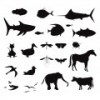
It requires a lot of energy to fast. If I go more than a few hours without eating, I get cranky, a little shaky, and I feel like crawling up into a ball and going to sleep forever. Ok, that was a little bit of an exaggeration, but I can't imagine fasting like a subantarctic fur seal pup, like the one pictured above with it's mother. This study says fur seal pups have to (repeatedly!) go very long periods without eating because the mother seal is rarely around. By very long periods of fasting, I mean anywhere between 4-6 days in most fur seal species. Can you imagine? Mother seals will come ashore for anywhere from 1-4 days to nurse their pups and then head out to sea to get the resources needed for milk production. These fasting periods start at birth and go until around 10 months of age.
So how do they fast for so long? A group of researchers carried out a study on 20 (10 female and 10 male) pups in the subantarctic fur seal breeding colony of La Mare aux Elephants on the northeast coast of Amsterdam Island. They monitored them to determine when they would be fasting. The pups were captured on certain days following the mother's departure, and subsequently every 4 days until the end of the natural fast. You can read the comprehensive methods section in the study.
The researchers found a variety of very interesting results, some of which are briefly noted below.
Phase I-phase II fasting
The fur seal pups seemed to maintain a phase II fasting period. Phase I fasting is characterized by a high but rapidly decreasing daily body mass loss and protein breakdown. Phase II is characterized with a LOW daily body mass loss and protein catabolism. There is also a phase III that leads back to high rates of mass loss and protein breakdown. The ability of the pups to maintain phase II shows their resistance to prolonged fasting by not losing much body mass. Researchers said there was no indication of a shift to phase III, as the pup's fat contents at the beginning of their fasting period was 48.5% (wow), suggesting that a fasting period of 67 to 91 days (no thank you) would be required for the pups to trigger the shift.
Reliance on body fat and protein sparing
As stated above, the beginning body fat content was about 48%. At the end of the prolonged fasting periods, the body fat content of a fur seal pup was just over 38%! Because of the initial, abnormally high fat content, it was easier for the pups to limit energy expenditure. The 48% fat content is actually very rare in the wild and usually only found in obese individuals and domestic animals (and hence why the obesity epidemic is worse than ever). When the pups are actually feeding in the few days the mother is present, the milk is so high in fat that it helps them get back some of what they've lost in the past few days.
Their high fat content also allows the pups to spare proteins during fasting to contribute to energy expenditure at less than 2%, according to the study. The researchers say this percentage of proteins going toward energy expenditure is 2-3 times LOWER than for species with a comparable fat content of over 40%.
Water conservation
Fur seal pups don't have to urinate as frequently because of the low levels of protein breakdown, which means there is less toxic product to get out of the body. This helps not only with water conservation, but also with preventing dehydration during the prolonged period of fasting. The study showed that water loss represented 10-11% of body mass loss during fasting in the pups.
Source: "Physiological response to extreme fasting in subantarctic fur seal (Arctocephalus tropicalis) pups: metabolic rates, energy reserve utilization, and water fluxes." Sept. 2009 American Journal of Physiology: Regulatory, Integrative and Comparative Physiology

